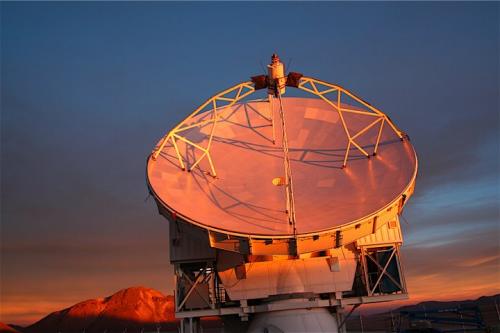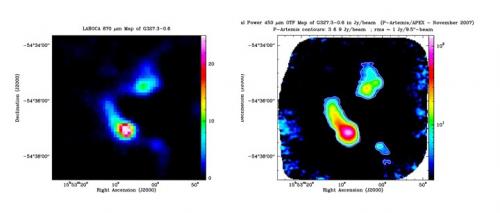Les premières cartographies avec le prototype de la caméra de nouvelle génération ArTéMiS ont été récemment réalisées sur le télescope APEX situé à Chajnantor au Chili. Ces observations ont été obtenues dans le cadre de trois projets scientifiques pendant le temps d'observation de l'ESO et suédois sur APEX. Les astronomes du SAp ont cartographié l'émission thermique à 450 microns des grains de poussière à travers des régions de formation d'étoiles ainsi qu'à travers des disques proto-planétaires et de débris. Parmi les régions observées figurent NGC3576, G327.3-0.6, S255, NGC2264, des régions de formation d'étoiles massives, HD97048 et Beta-Pictoris, des disques proto-planétaires et de débris. La figure ci-contre illustre ces observations en présentant la carte de NGC3576 à 450 microns.
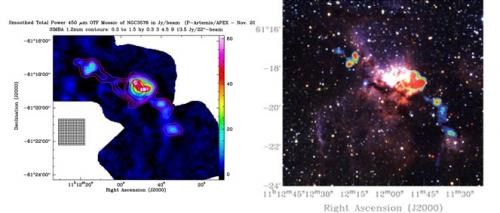
NGC3576. Left: 450-µm dust continuum emission image with p-ArTéMiS and 1.2-mm contour overlaid. The angular size of p-ArTéMiS filled bolometer array is shown. 450-µm observations resolve the 1.2 mm emission in massive clumps in which high-mass stars currently form. Right: Near-infrared image with 450-µm image overlaid. The bright central region harbour a cluster of young stars and a HII region. 450-µm emission arises from the edge of HII region as well as from adjacent 'dark', reservoirs of cold gas.
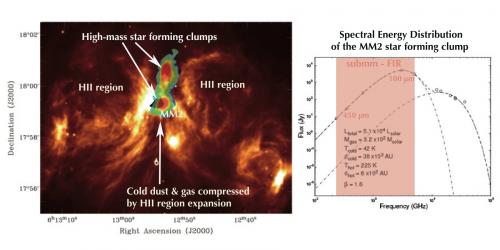
S255. Left: Spitzer IRAC image of thermal dust emission and PAH emission around HII regions. The RGB image overlaid on the Spitzer image is the cold dust emission from star-forming clumps as detected by the p-ArTeMiS bolometer array on APEX at 450 µm. Right: SED diagram of one of the star-forming clump that is built with dust emission from 1 mm to 8 µm. The cold component is mainly constrained by the submm/FIR emission of dust that allows to estimate the luminosity and dust temperature, and therefore deduces the clump mass. Each clump is a progenitor of a star cluster or high-mass protocluster
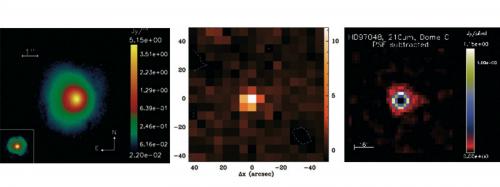
HD97048. Left: VLT/VISIR image of the HD97048 protoplanetary disk at 8.6 µm, showing its flared, extended surface (Lagage et al. 2006). The lower left inset is the VLT/VISIR PSF as a comparison. Middle: Observation of HD97048 with p-ArTeMiS/APEX at 450-µm with a pixel of 6''. Right: the HD97048 emission at 200 µm has been simulated using a radiative transfer code. A scaled PSF observation has been removed, showing that the disk image is resolved at 200 µm. This shows the potential to constrain the outer disk radius, which is very difficult to determine in the mid-infrared because of the lack of sensitivities to very cold dust.

